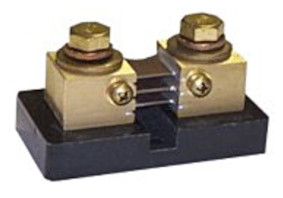Current Shunt Discussion
Current Shunt Discussion
April 15th, 2020:
Direct current instrument shunts are used to extend the range of ammeters whenever the current to be measured is too large to be passed through the instrument - typically currents above 50 amperes. The shunt, therefore, is a diverter which is used to "shunt" the majority of the current around the indicating instrument. The current shunt is essentially a specifically designed resistor which delivers a millivolt output (to a millivolt meter or instrument) in proportion to the current flowing through the resistor.
In addition, shunts are also used where low current must be applied to the metering panel or where the metering panel is quite a distance from the circuit carrying the current to be measured and it would not be feasible to run large cables or bus bars to the metering panel or switchboard.

Design and Construction
Since the shunt is a resistor which operates in a varying ambient temperature environment and generates heat whenever current flows through it, we design the shunt resistance portion with a special alloy which has, essentially, a constant resistance value through its operating range. In addition to using a precision resistance alloy with a negligible temperature coefficient of resistance, the alloy must have a low resistivity in order to keep the self-heating to a minimum. It must also have a low thermal E.M.F. against copper. All Ram Meter Inc. current shunts are designed using a special shunt manganin alloy which meets all these criteria.
The final design consideration is size, which relates to self-heating as well as its cooling characteristics to dissipate the heat generated by the resistance alloy. Ram Meter Inc. current shunts are optimally designed for size based on these factors. Generally, the higher current shunts (bus-type) are designed with large end blocks (current terminals) for switchboard use so that they can be installed in the bus or connection bar structure of the circuit whose current is to be measured. The lower current shunts (portable-type) are designed with an insulating base and are intended to be laid on, or fastened to, any flat surface. These shunts may also be used for switchboard applications where the current is relatively low and connection bars are not used.
Shunt Selection
Selection of current ratings should be based on a normal operating current of 2/3 the rated value of the shunt.
Custom Shunt Design
Ram Meter Inc. shunts are standardized to deliver either 50 millivolts or 100 millivolts at their full rated current. However, there are times when other millivolt ranges are desired or when other physical sizes or configurations are more suitable for an application. In these cases, fill out our Ram Meter Inc. Special Shunt Requirement Form and e-mail it to our sales department at [email protected] and we will come up with a design to fit your needs.
Shunt Standards
All Ram Meter Inc. commercial shunts are designed in accordance with IEEE STD 316-1971. Our military lightweight shunts are manufactured in accordance with MIL-S-61B. Our commercial lightweight series of shunts are designed similar to the military lightweight shunts except that commercial materials are utilized. We also manufacture shunts in accordance with MIL-I-1361B when specified.
Shunt Installation
The proper installation of a shunt is extremely important in maintaining its accuracy during normal use. The major factor is heat generated by the shunt itself, along with the ambient temperature influence based on air movement and heat radiated to the shunt by other heat-radiating devices located nearby.
The shunt is cooled by radiating heat to its surroundings and convection air passing through the shunt while conducting the majority of the heat through its connecting cables or bus bars. Therefore, the following points must be considered:
- BUS-TYPE SHUNTS are intended to be installed in the bus bar structure.
- PORTABLE-TYPE SHUNTS have an insulating base which can be fastened to any flat surface.


In each of the above cases, the blades are to be vertical with the longitudinal axis horizontal.
The cables or bus bars of proper cross-section (one square inch of copper per 1,000 amps) used to connect the shunts into the circuit must be tightly bolted to the shunt current terminals with the bus bars inserted to within 1/4 inch of the bottom of the bus bar slots. Any unused slots are to be filled with 1/4 inch copper pieces in order to fully fill all the slots.
These shunts should operate at a temperature rise not to exceed 176°F (80°C) when carrying their rated current.
Any other types of mounting or environment other than what has been described above may require derating of the shunt.
Shunts should be installed so that they will not be damaged by thermal expansion forces in the connecting bus bars or by short circuit forces. Shunts are inherently weaker than their current connections and special flexibility may be needed at times.
Wherever possible, all shunts should be connected in the ground side of the line. Portable type shunts with insulating bases, when used on circuits above 750 volts, must be mounted in the grounded side of the circuit.
When more than one bus bar is to be connected to each end of single terminal shunts, these bars should be distributed as equally as possible on each side of the shunt terminals.
Shunt Leads
Standard shunt leads have a total resistance of 0.065 ohms and they range in length from 5 to 7 feet. The shunt leads are considered as a part of the metering circuit and therefore their voltage drop must be considered when calibrating the millivolt meter when a high degree of accuracy is to be achieved.
AC Applications
While current shunts ae typically used in DC (direct current) applications, they may also be used in AC (alternating current) applications with the following understanding: Ram Meter Inc. shunts have a very small inductance and exhibit a negligible effect (AC impedance) up to 1 kilohertz, and can be used up to 5 kilohertz where a slightly noticeable effect (AC impedance) takes place. Therefore, we recommend that you investigate the use of a conventional direct current shunt in your AC application to establish whether or not it is suitable for your application.
On low current AC shunts, we can design a non-inductive shunt which will operate on much higher frequencies. However, once again, you must evaluate the design to see if it is suitable for your application.
Adjusted Accuracy
Ram Meter Inc. shunts are adjusted to within +/-0.25% nominal value with an applied current that will not raise the temperature of the terminal blocks more than 50°F (10°C) with an ambient room temperature of 77°F (25°C) +/-2°.
Rated Accuracy
Commercial shunts up to 1,000 amps have an accuracy of +/-0.33%
Commercial shunts 1,000 amps and above have an accuracy of +/-0.5%
Commercial lightweight shunts have an accuracy of +/-0.6%
Military lightweight shunts have an accuracy of +/-0.6%
This allows for self-heating variation at the higher current values and variance in connections.
What is the difference between Adjusted & Rated Accuracy? The Adjusted Accuracy is when the shunt is being calibrated (adjusted) for the first time after it is manufactured. This is done at room temperature (77°F / 25°C) with a current low enough to not raise the temperature of the shunt. So if the shunt is used at 77°F / 25°C it will be this accurate. The Rated Accuracy is how accurate the shunt will be with up to 2/3 of the rated current running through it continuously. In this case the shunt will heat up and the resistance can change as it heats up. Therefore, the accuracy will change to be within the rated accuracy.
Calibration and Certification
Ram Meter Inc. shunt calibration and certification are traceable to NIST.

At Ram Meter Inc., we carry a wide selection of Current Shunts in all sorts of sizes and ratings. Still not sure which current shunt is right for your application? CONTACT US today with your needs and one of our highly qualified salespeople will assist you.
